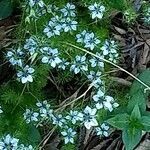Stem (5)-20-50 cm tall, branching above. Segments of rosette lvs linear, those of cauline lvs filiform. Involucre present, of 5 finely dissected lvs, twice as broad as the fl. Fls 2-3 cm diam. Sepals in several whorls, blue, ovate, acute, clawed, the innermost sometimes 3-fid. Petals usually 0. Styles 5. Capsule glabrous, ovoid, swollen, 15-30 × 10-20 mm, 10-locular but only 5 locules fertile; styles 15-25 mm long at fruiting. Seeds black, c. 2 mm long, transversely ridged.
An upright bushy annual plant. It grows 40-60 cm high and 20-25 cm wide. The leaves are feathery. The flowers are sky-blue. They are 2.5-5 cm across. The flowers sit inside wispy leaves. The fruit is an inflated seed capsule. It is striped and has short pointed horns.
Plant 3–6 dm; fls bluish, 3–4 cm wide, closely subtended by an involucre of dissected lvs; staminodes villous; 2n=12. Native of s. Europe, occasionally escaped from cult. in our range.












